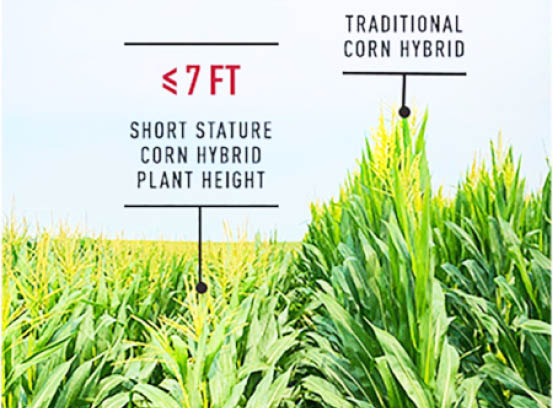AGRO SOLUTIONS: Is short corn the future?
In our changing climate, feeding a growing world population will require many solutions, one of which may include short corn. Bryan Leake is the Director of External Communications for Bayer Crop Science, North America. He believes short-statured corn varieties can stand up better against increasingly frequent significant weather events and may help growers mitigate crop […]

short corn
In our changing climate, feeding a growing world population will require many solutions, one of which may include short corn.
Bryan Leake is the Director of External Communications for Bayer Crop Science, North America. He believes short-statured corn varieties can stand up better against increasingly frequent significant weather events and may help growers mitigate crop loss, while enabling them to be more prescriptive in their use of inputs.
He said, “Shorter plant architecture enables increased opportunities to unlock yield potential and could lead to more efficient use of key resources while minimising annual crop losses due to lodging and greensnap.”
Advantages
Short corn may have a variety of advantages such as:
Reduced risk of lodging.
Improved spacing interval between the tassel and the uppermost ear to help improve pollination.
The opportunity to plant at higher densities (where the genetics support this), increasing the leaf surface area per acre (for maximum photosynthesis) as well as the number of ears per acre, resulting in higher yield.
Narrowed row spacing and increased plant populations, while simultaneously improving equidistant plant spacing (the amount of space a corn plant has on all four sides).
Improved in-season access for spraying or other purposes.
Improved erosion control: as rows narrow and canopy density becomes thicker and more consistent, raindrops are less likely to land on bare soil. Equidistant plant spacing may also lead to less water “channeling”, which can potentially reduce erosion.
Thompson emphasised that short corn did not necessarily require lower nutrient input levels.
He said, “A certain amount of nutrients such as nitrogen are required to generate a bushel of corn. That figure is basically the same whether corn is tall or short. However, shorter corn can allow growers to apply with greater precision and timelier in-season applications, which could lead to efficiencies.”
Benefits
Leake says that in addition to benefits including pest protection, access, yield potential and season-long access, short-statured corn decreases this kind of weather-related production risk.
He said, “There is a reduced risk of losses from high winds and challenging weather conditions,” Leake says. “Short-stature corn hybrids significantly increase tolerance to lodging and greensnap, withstanding wind gusts up to at least 50 mph.”
The reduced plant height of short-statured corn hybrids also provides growers the flexibility to further optimise and prescribe fertility, pest and disease management with standard ground equipment.
He added that, “Season-long access provides a more precise and timely application of crop protection and other inputs when the crop needs them most or when field conditions allow.”
With respect to yield potential, Leake said the production stability of their Smart Corn System provided growers with more flexibility, peace of mind and reduced overall business risk.
He further said, “The root systems of breeding trait short stature corn hybrids have demonstrated the potential to explore more soil volume faster, which could lead to increased stress tolerance, better utilisation of nutrients and water, and greater yield stability,” adds Leake.
What’s next?
As for what can be expected over the next decade in terms of short-statured crops, Leake says Bayer is focused on bringing short-statured corn systems to markets around the globe.
Thompson says Stine Seed Company has been on the forefront of advocating for shorter corn that growers can plant at higher densities to maximise yields.
He says the company is pleased that the industry is recognising this trend as the future for corn production.
He said, “We will continue to breed and develop new, higher-yielding corn lines into the future. We will not place any stipulations on height, but rather will let yield and standability inform our decisions.”
Source: Seed World
